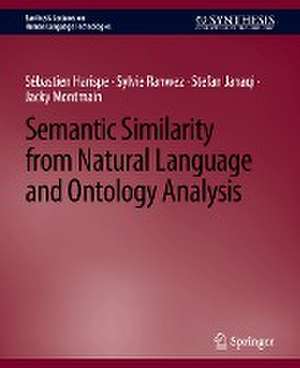Semantic Similarity from Natural Language and Ontology Analysis: Synthesis Lectures on Human Language Technologies
Autor Sébastien Harispe, Sylvie Ranwez, Stefan janaqi, Jacky Montmainen Limba Engleză Paperback – 26 mai 2015
Din seria Synthesis Lectures on Human Language Technologies
- 20%
 Preț: 223.34 lei
Preț: 223.34 lei - 20%
 Preț: 282.54 lei
Preț: 282.54 lei - 20%
 Preț: 277.60 lei
Preț: 277.60 lei - 20%
 Preț: 227.81 lei
Preț: 227.81 lei - 20%
 Preț: 227.29 lei
Preț: 227.29 lei - 20%
 Preț: 227.12 lei
Preț: 227.12 lei - 20%
 Preț: 274.48 lei
Preț: 274.48 lei - 20%
 Preț: 479.30 lei
Preț: 479.30 lei - 20%
 Preț: 224.65 lei
Preț: 224.65 lei - 20%
 Preț: 415.47 lei
Preț: 415.47 lei - 20%
 Preț: 357.06 lei
Preț: 357.06 lei - 20%
 Preț: 388.17 lei
Preț: 388.17 lei - 20%
 Preț: 226.64 lei
Preț: 226.64 lei - 20%
 Preț: 478.36 lei
Preț: 478.36 lei - 20%
 Preț: 224.50 lei
Preț: 224.50 lei - 20%
 Preț: 334.38 lei
Preț: 334.38 lei - 20%
 Preț: 225.99 lei
Preț: 225.99 lei - 20%
 Preț: 225.67 lei
Preț: 225.67 lei - 20%
 Preț: 166.43 lei
Preț: 166.43 lei - 20%
 Preț: 424.05 lei
Preț: 424.05 lei - 20%
 Preț: 358.95 lei
Preț: 358.95 lei - 20%
 Preț: 225.67 lei
Preț: 225.67 lei - 20%
 Preț: 227.12 lei
Preț: 227.12 lei - 20%
 Preț: 270.04 lei
Preț: 270.04 lei - 20%
 Preț: 537.06 lei
Preț: 537.06 lei - 20%
 Preț: 225.67 lei
Preț: 225.67 lei - 20%
 Preț: 228.13 lei
Preț: 228.13 lei - 20%
 Preț: 353.61 lei
Preț: 353.61 lei - 20%
 Preț: 227.12 lei
Preț: 227.12 lei - 20%
 Preț: 422.25 lei
Preț: 422.25 lei - 20%
 Preț: 270.69 lei
Preț: 270.69 lei - 20%
 Preț: 354.92 lei
Preț: 354.92 lei - 15%
 Preț: 519.19 lei
Preț: 519.19 lei - 20%
 Preț: 226.97 lei
Preț: 226.97 lei - 20%
 Preț: 384.53 lei
Preț: 384.53 lei - 20%
 Preț: 226.64 lei
Preț: 226.64 lei - 20%
 Preț: 503.01 lei
Preț: 503.01 lei - 20%
 Preț: 358.04 lei
Preț: 358.04 lei - 20%
 Preț: 330.75 lei
Preț: 330.75 lei - 20%
 Preț: 327.95 lei
Preț: 327.95 lei - 20%
 Preț: 299.48 lei
Preț: 299.48 lei - 20%
 Preț: 228.28 lei
Preț: 228.28 lei - 20%
 Preț: 382.39 lei
Preț: 382.39 lei - 20%
 Preț: 418.59 lei
Preț: 418.59 lei - 20%
 Preț: 326.13 lei
Preț: 326.13 lei - 20%
 Preț: 271.86 lei
Preț: 271.86 lei
Preț: 333.40 lei
Preț vechi: 416.75 lei
-20% Nou
Puncte Express: 500
Preț estimativ în valută:
63.80€ • 66.37$ • 52.67£
63.80€ • 66.37$ • 52.67£
Carte tipărită la comandă
Livrare economică 15-29 aprilie
Preluare comenzi: 021 569.72.76
Specificații
ISBN-13: 9783031010286
ISBN-10: 3031010280
Ilustrații: XV, 238 p.
Dimensiuni: 191 x 235 mm
Greutate: 0.45 kg
Editura: Springer International Publishing
Colecția Springer
Seria Synthesis Lectures on Human Language Technologies
Locul publicării:Cham, Switzerland
ISBN-10: 3031010280
Ilustrații: XV, 238 p.
Dimensiuni: 191 x 235 mm
Greutate: 0.45 kg
Editura: Springer International Publishing
Colecția Springer
Seria Synthesis Lectures on Human Language Technologies
Locul publicării:Cham, Switzerland
Cuprins
Preface.- Acknowledgments.- Introduction to Semantic Measures.- Corpus-Based Semantic Measures.- Knowledge-Based Semantic Measures.- Methods and Datasets for the Evaluation of Semantic Measures.- Conclusion and Research Directions.- Bibliography.- Authors' Biographies .
Notă biografică
Sèbastien Harispe holds a Master's and PhD in Computer Science from the University of Montpelier II. His research focuses on Artificial Intelligence and more particularly on the diversity of methods which can be used to support decision making from text and knowledge base analysis, e.g. Information and Extraction and Knowledge inference. He proposed several theoretical and practical contributions related to semantic measures. He is the project leader and main developer of the Semantic Measures Library project, a project dedicated to the development of open source software solutions for semantic measures computation and analysis.
Sèbastien Harispe holds a Master's and PhD in Computer Science from the University of Montpelier II. His research focuses on Artificial Intelligence and more particularly on the diversity of methods which can be used to support decision making from text and knowledge base analysis, e.g. Information and Extraction and Knowledge inference. He proposed severaltheoretical and practical contributions related to semantic measures. He is the project leader and main developer of the Semantic Measures Library project, a project dedicated to the development of open source software solutions for semantic measures computation and analysis.
Stefan is a research member of the LGI2P Research Center team at the School of Mines. He holds a PhD in Computer Science from University Joseph Fourier, Grenoble (France), dealing with geometric properties of graphs. His research focuses on mathematical models for optimization, image treatment, evolutionary algorithms and convexity in discrete structures such as graphs.
Jacky Montmain received the Master's degree from the Ecole Nationale Superieure d'Ingenieurs Electriciens de Grenoble France in 1987 and a PhD from the National Polytechnic Institute in 1992; both in control theory. He was a research engineer at the French Atomic Energy Commission from 1991 to 2005 where he was appointed as Senior Expert in the field of Mathematics, Computer Sciences, Software, and System Technologies in 2003. He is currently a Professor at the School of Mines. His research interests include the application of artificial intelligence techniques to model-based diagnosis and supervision, industrial performance improvement, multicriteria and fuzzy approaches to decision-making.